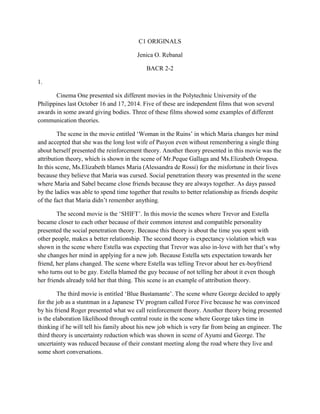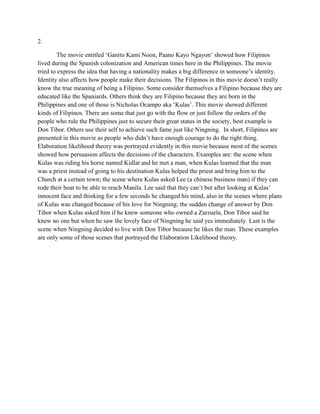C1 originals final paper
- 1. C1 ORIGINALS Jenica O. Rebanal BACR 2-2 1. Cinema One presented six different movies in the Polytechnic University of the Philippines last October 16 and 17, 2014. Five of these are independent films that won several awards in some award giving bodies. Three of these films showed some examples of different communication theories. The scene in the movie entitled ŌĆśWoman in the RuinsŌĆÖ in which Maria changes her mind and accepted that she was the long lost wife of Pasyon even without remembering a single thing about herself presented the reinforcement theory. Another theory presented in this movie was the attribution theory, which is shown in the scene of Mr.Peque Gallaga and Ms.Elizabeth Oropesa. In this scene, Ms.Elizabeth blames Maria (Alessandra de Rossi) for the misfortune in their lives because they believe that Maria was cursed. Social penetration theory was presented in the scene where Maria and Sabel became close friends because they are always together. As days passed by the ladies was able to spend time together that results to better relationship as friends despite of the fact that Maria didnŌĆÖt remember anything. The second movie is the ŌĆśSHIFTŌĆÖ. In this movie the scenes where Trevor and Estella became closer to each other because of their common interest and compatible personality presented the social penetration theory. Because this theory is about the time you spent with other people, makes a better relationship. The second theory is expectancy violation which was shown in the scene where Estella was expecting that Trevor was also in-love with her thatŌĆÖs why she changes her mind in applying for a new job. Because Estella sets expectation towards her friend, her plans changed. The scene where Estella was telling Trevor about her ex-boyfriend who turns out to be gay. Estella blamed the guy because of not telling her about it even though her friends already told her that thing. This scene is an example of attribution theory. The third movie is entitled ŌĆśBlue BustamanteŌĆÖ. The scene where George decided to apply for the job as a stuntman in a Japanese TV program called Force Five because he was convinced by his friend Roger presented what we call reinforcement theory. Another theory being presented is the elaboration likelihood through central route in the scene where George takes time in thinking if he will tell his family about his new job which is very far from being an engineer. The third theory is uncertainty reduction which was shown in scene of Ayumi and George. The uncertainty was reduced because of their constant meeting along the road where they live and some short conversations.
- 2. 2. The movie entitled ŌĆśGanito Kami Noon, Paano Kayo NgayonŌĆÖ showed how Filipinos lived during the Spanish colonization and American times here in the Philippines. The movie tried to express the idea that having a nationality makes a big difference in someoneŌĆÖs identity. Identity also affects how people make their decisions. The Filipinos in this movie doesnŌĆÖt really know the true meaning of being a Filipino. Some consider themselves a Filipino because they are educated like the Spaniards. Others think they are Filipino because they are born in the Philippines and one of those is Nicholas Ocampo aka ŌĆśKulasŌĆÖ. This movie showed different kinds of Filipinos. There are some that just go with the flow or just follow the orders of the people who rule the Philippines just to secure their great status in the society, best example is Don Tibor. Others use their self to achieve such fame just like Ningning. In short, Filipinos are presented in this movie as people who didnŌĆÖt have enough courage to do the right thing. Elaboration likelihood theory was portrayed evidently in this movie because most of the scenes showed how persuasion affects the decisions of the characters. Examples are: the scene when Kulas was riding his horse named Kidlat and he met a man, when Kulas learned that the man was a priest instead of going to his destination Kulas helped the priest and bring him to the Church at a certain town; the scene where Kulas asked Lee (a chinese business man) if they can rode their boat to be able to reach Manila. Lee said that they canŌĆÖt but after looking at KulasŌĆÖ innocent face and thinking for a few seconds he changed his mind, also in the scenes where plans of Kulas was changed because of his love for Ningning; the sudden change of answer by Don Tibor when Kulas asked him if he knew someone who owned a Zarzuela, Don Tibor said he knew no one but when he saw the lovely face of Ningning he said yes immediately. Last is the scene when Ningning decided to live with Don Tibor because he likes the man. These examples are only some of those scenes that portrayed the Elaboration Likelihood theory.

